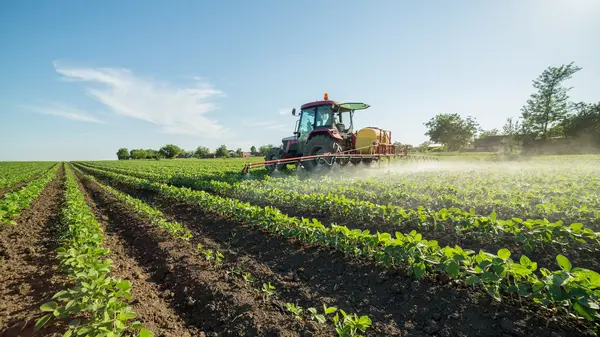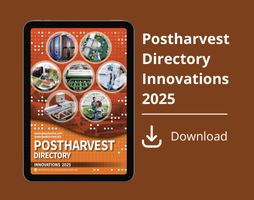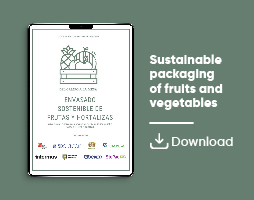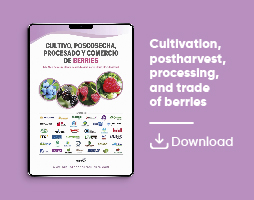Actualidad
KCl as preharvest treatment to control stem end rot in mango
Dipali D. Hirani et al. research shows that the treatment with 3.0 g l-1 potasium chloride significantly lowered the incidence of disease to 00 per cent and increased the shelf life to 13 days, according to the results
The mango (Mangifera indica L.), sometimes referred to as the "king of fruits," is an essential tropical fruit that has both therapeutic and nutritional benefits. Despite its importance, post-harvest diseases, especially stem end rot (SER) brought on by fungi such as Lasiodiplodia theobromae, pose a threat to mango production.
The effectiveness of potassium chloride (KCl) as a pre-harvest treatment to manage SER in mangoes is investigated in this work.
One month afterwards fruit set, mango fruits of the Kesar variety were treated with six different doses of KCl (0.5 to 3.0 g/l). Fruits were assessed for SER incidence and shelf life after harvest.
The treatment with 3.0 g l-1KCl significantly lowered the incidence of disease to 00 per cent and increased the shelf life to 13 days, according to the results.
On the other hand, the control fruits had a lower shelf life of seven days and a 50 per cent disease incidence.
In comparison to the control, treatments with 1.0 g l-1 and 0.5 g l-1KCl also markedly decreased the incidence of disease and increased shelf life.
By lowering dependency on chemical fungicides, this treatment not only improves fruit quality and shelf life but also fits with sustainable agriculture methods.
Introduction
Economic development is significantly influenced by the horticulture industry, which includes fruits, vegetables, tuber crops, mushrooms, ornamental plants, spices, plantation crops aromatic and medicinal plants. Mangoes, citrus fruits and bananas account for 70% of all fruit crops produced (Ganeshmurthy et al., 2023).
There are 69 species in the genus Mangifera, but only the mango yields fruit that is edible (Ekanayake et al., 2019). Mango Mangifera indica L. is the king of all fruit sand it is a member of the order sapindales and the family Anacardiaceae (anusha et al., 2023) having a basic chromosome number of 10 (2n = 4x = 40) (Hassan zai, 2024).
Mango is the national fruit of India and considered as king of fruits due to its delicious taste, flavor aroma and attractive colour. It is often cultivated in Southeast Asian tropical and subtropical areas.
Mangoes are said to have originated in India, Burma (Myanmar) and even the Malay area. It began to move to other continents in the sixteenth century (Anusha et al., 2023).
The increasing demand for mangoes around the world presents problems with fruit quality, particularly with regard to post-harvest diseases, which are a major cause of crop loss.
Post-harvest losses of fresh mangoes in India are reported to be 25–40 per cent; in Asian countries, microbial degradation accounts for 17.0–26.9 per cent of these losses.
Disease-related post-harvest losses of 20–25% are a significant concern for India's fruit industry (Vahia, 2021).
Fruits undergo significant biochemical and physiological changes as they ripen, including ethylene emission in climacteric fruit and other phytohormone changes, soluble sugar accumulation, cell wall loosening, a drop in phytoanticipin and phytoalexin levels, a rise in inducible plant defence mechanisms and adjustments to ambient conditions (Galsurker, 2018).
Stem end rot and anthracnose, the two main postharvest diseases
The two main postharvest diseases that affect fruit quality, shelf life and marketability are stem-end rot (SER) and anthracnose (Krishnapillai and Wijeratnam, 2013).
Fungal pathogens known to be causing the SER in mango are Dothiorella dominicana, Dinoderus mangiferae, Lasiodiplodia theobromae, Phomopsis mangiferae, Cytosphaera mangiferae, Pestalotiopsis sp. (Johnson et al., 1992) (adikaram, 2023) with the major causal organism of mango stem end rot disease is Lasiodiplodia theobromae (Pat.) [Syn.: Botryodiplodia theobromae (Pat.)] Griff. & Maubl.
The SER disease is characterized by small dark-brown lesions in the peel surrounding the fruit stem end, eventually leading to soft and watery decay, causing complete fruit rot (Galsurker et al., 2020 and Yeo, 2023).
Fungicides are commonly used to control SER, but their widespread and excessive use has led to drugresistant pathogens and environmental pollution (Zhan, 2023).
There have been reports of disease control in plants and harvested fresh products through the induction of host resistance and activation of defensive mechanisms (Nishansala, 2015).
Potasium, the "quality element"
As the "quality element" for crops (Usherwood As the "quality element" for crops (Usherwood, 1985), potassium is essential for several aspects of crop quality, including vitamin levels, taste, fruit size, appearance, color, sweetness, acidity, and shelf life (Ganeshamurthy et al., 2011).
Sufficient potassium increases plants' ability to produce defence mechanisms, which increases their resistance to disease (Perrenoud, 1994).
As a result, fertilization provides enough potassium, which serves as a health insurance policy (Rathnayake et al., 2010). Chloride ions serve several important roles in plants:
- they help maintain cell hydration and turgor by acting as osmotic solutes;
- they regulate the opening and closing of stomata;
- they play a part in various biochemical functions during plant metabolism; and
- they can help prevent disease infections (MAAS, 1986a). Additionally, chloride is also involved in activating enzymes and participating in other metabolic processes within plants.
In this study, an attempt was made to find out the possibility of using KCl as an effective agent of controlling stem-end rot disease of mango.
Sources
The impact of pre-harvest potassium chloride spray to mitigate mango stem end rot
Dipali D. Hirani, D.H. Tandel, Rahul L. Joshi, Jeslin Jose and Kishan R. Bhanderi
Plant Archives Vol. 25, Supplement 1, 2025 pp. 1594-1598
https://doi.org/10.51470/PLANTARCHIVES.2025.v25.supplement-1.220
https://www.plantarchives.org/article/220%20THE-IMPACT-OF-PRE-HARVEST-POTASSIUM-CHLORIDE-SPRAY-TO-MITIGATE-MANGO-STEM-END-ROT.pdf
Picture
Prevalence of mango stem-end rot disease in Côte d'Ivoire and identification of associated fungal pathogens
https://link.springer.com/article/10.1007/s40858-024-00636-6











